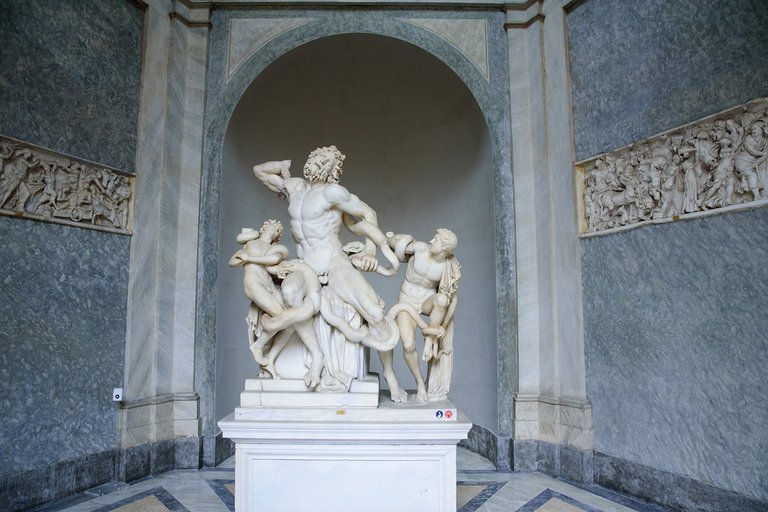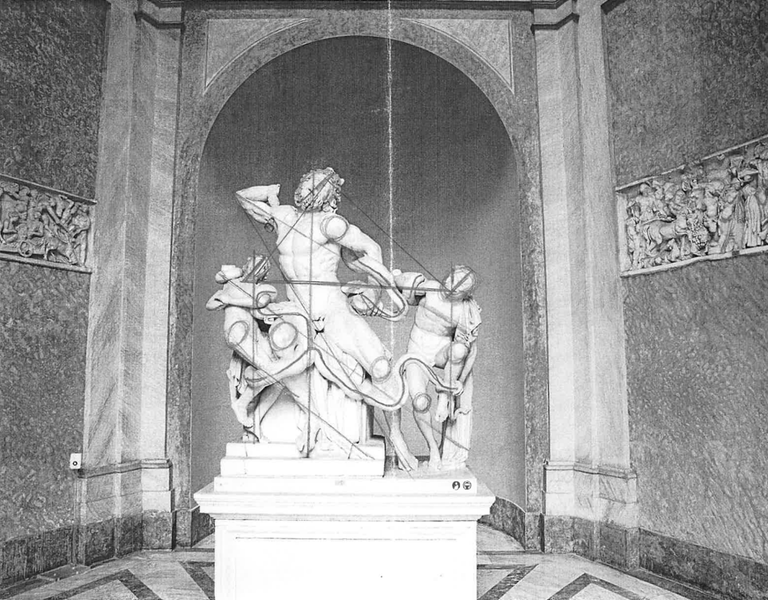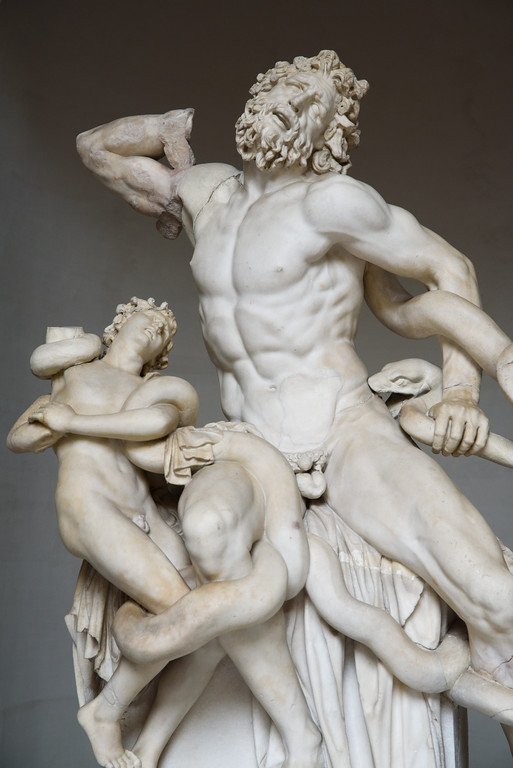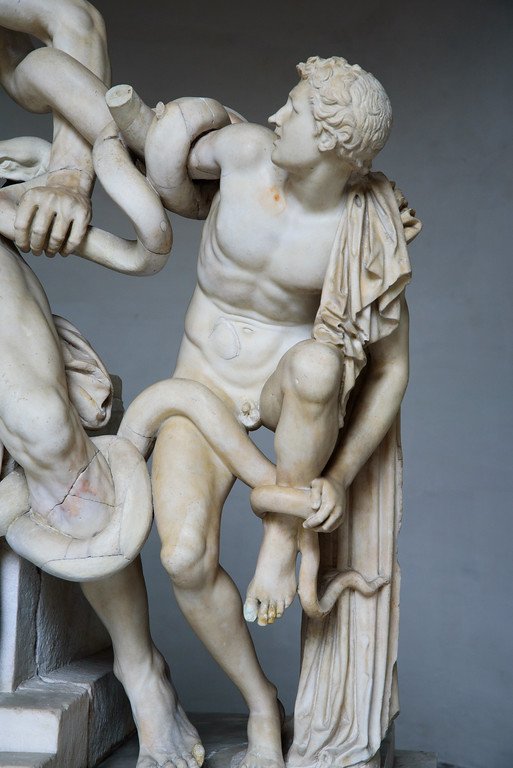The Art Talk theme for 2024 is visual analysis. This month I present Laocoon from the Vatican Museum in Rome. The last museum in the museum series during 2023 I highlighted the Vatican Museum and mentioned that "I wrote a paper for my Art history class on a piece that I saw there." Below is my paper for Cambridge.

Figure 1. Laocoon, 40-20 BC, Vatican Museum, Rome, Italy
This dynamic Parian marble statue was found in Rome, Italy in 1506 during the Italian Renaissance. Throughout this period individuals were looking back to classical antiquity, particularly Greece, for inspiration, rebirth, and revival. Laocoon is understood to be the work of three artists from Rhodes, Greece: Agesander, Polydoros, and Athandoros [Figure 1]. The sculpture is assumed to be a rendition of the priest Laocoon and his two sons being attacked by sea serpents after having warned the Greeks not to accept the Trojan horse, as told in the Aeneid. [1] When this Hellenistic sculpture was found by a farmer in Rome, Pope Julius II was so thrilled that he immediately purchased and installed it the Vatican Museum. The enthusiasm surrounding Laocoon has continued to the current day. Countless people have viewed Laocoon and many have also expressed their thoughts, ideas and critiques in the 500+ years since its remarkable discovery. This essay explores the artists use of composition, symbolism, and physicality to create a dynamic statue that reflects Laocoon’s character in marble. The deliberate use of compositional elements such as the triangle and vertical lines draw our attention to Laocoon as a calming influence amidst chaos and suggest a man of spiritual sensitivity. Furthermore, symbolism is used in both the size of the father and the pedestal prompting not only the sons but also us, as the viewer, look up to Laocoon. Perhaps, the most compelling, is the physicality of Laocoon. His idealized Hellenistic Greek body, especially the representation of his suffering is an indication of his model character.
The largest figure in the piece is an adult male with a very fit and defined body. He is arching his back and turning his head in pain as one of the serpents bites his left hip. On either side are two adolescent males, also fighting to free themselves from the sea serpents grasp. The boy on the right is likely the younger of the two boys as he has no defined muscles. He is pushing the serpent away with his left hand, and both his legs are lifted by a snake so that he is falling backwards. His head and face are turned toward the older man. The boy on the left of the man is the older of the two children and has more muscles in his chest, abdomen, and legs. There is a serpent coiled around his right arm and he is using his left hand to push away its tail. All three figures are missing a hand and parts of their arms from the years when the sculpture was in an underground room in a vineyard in Rome, Italy.
[2]

Figure 2. Copy of Laocoon with sketching to show the lines and compositional elements
Composition plays an important role in showing viewers Laocoon’s character. This sculpture is full of motion, leading the viewer’s eye around the statue [Figure 2]. Strong vertical, diagonal, and horizontal lines as well as the curving lines of the serpents all compete for the viewers’ attention. All of the lines create a sense of chaos and uncertainty. The triangle formed by the head of each figure creates some sense of stability and provides a spot upon which the viewers can rest: the father is the highest point in the triangle and anchor in that respite. Laocoon’s head is also the highest point of three vertical lines from each figure. Vertical lines suggest spirituality, raising beyond the mortal and adding to the viewer’s sense that Laocoon is wiser than other humans and therefore worthy of admiration. The vertical and triangular lines are evidence that Laocoon is a stabilizing force and a spiritual person.
Beyond composition, Laocoon’s immense size and the pedestal’s dominance reflect his admirable character. Though most of the historical analysis of Laocoon is positive, in 1883 Lucy Mitchell, one of the first female classical archaeologists and ancient art historians, critiqued it very harshly. She asserted that:
The colossal form of the father, towering above his sons, is disproportionately larger than theirs; and his anguish seems correspondingly great. No consciousness of their distress is evident in his face or form, in which pain, terrible and blinding, seems to have smothered every other feeling. This we see in the aimless movements of his legs, the agony of the cramped toes, the terrible contraction and writhing of the loins, the blind grasping at the serpent’s neck with the left hand, and the tortured expression of the face. In vain do we look here for a heroic struggling with destiny…[3]
In her critique, Mitchell notes that the father is obviously larger than his adolescent sons and is a man unconcerned with the pain of others. Mitchell also mentions that the father is oblivious to the distress of his children but this view might overlook some important details As I study this sculpture, I see a father who is in pain and anguish, as Mitchell asserts, and two boys looking up to their father as a protector and hero. Both boys are scared and fighting the serpents attacking them. They look to their father for help [Figure 3 and Figure 4]. He must have proved, in times past, that he is someone that they could trust and admire, for in their time of desperation they turn their gaze to their father.
 Figure 3. Detail of younger son looking at his father
Figure 3. Detail of younger son looking at his father
 Figure 4. Detail of older son looking at his father
Figure 4. Detail of older son looking at his father
In addition to the large figure of the father, there is also the symbolic element of the pedestal. The artists used this pedestal both as a base or support for the structure of the piece and as a way to show the greatness of Laocoon, suggesting that we, like his children, should look up and admire him.
 |  |  |
|---|---|---|
| Figure 5. Marble Statue of a Kuros (youth), 590-580 B.C Metropolitan Museum of Art, | Figure 6. Sculpture of a Victorious Youth, 300-100 B.C. J. Paul Getty Museum | Figure 7. Laocoon, 40-20 B.C. Vatican Museum |
In his 2015 book Defining Beauty Ian Jenkins claims, “Outward physical perfection was believed to reflect inner moral virtue, and victorious athletes gained near heroic status.” [4] During the archaic period (700--401 B.C.) the body was represented in a simplistic and symmetrical fashion as with the stiff Kuros statue in the Metropolitan Museum of Art in New York City [Figure 5]. Kouros and Kore were made to represent gods or deities, to be presented as gifts, and or to serve as grave markers. There was little variation and the Kouros lacked “any sense of individualism or of character.” [5]
In the classical period (401-323 B.C.), artists started to bring a sense of naturalism and movement to sculpture. Contrapposto is introduced during this period and is seen in the bronze Sculpture of a Victorious Youth, in the J. Paul Getty Museum in Los Angeles, California [Figure 6]. The poses during this time are more interesting and dynamic. In this sculpture the young man is reaching for the wreath on his head and has a more natural posture.
During the Hellenistic period (323-31 BC) art and sculpture are full of drama, suffering, and realism. In this beautifully sculpted marble, [Figure 7] Laocoon and his sons are being attacked by two mighty serpents. Far from the stiff and homogeneous poses of the Kouros, Laocoon and his sons’ bodies are full of life and vitality. The contrapposto poses of each figure, as they turn and contort, convey movement and suffering. Each figure in the group is sculptured realistically, and therefore viewers feel more for them in their plight. The naked, muscled, idealized body of the father suggests his inner moral virtue and leads us to admire him for both his body and his character.
In 1764 Johann Joachim Winckelmann, the father of Classical Archeology and Art history described Laokoon as:
an image of the most extreme suffering, which acts here on all the muscles, nerves, and veins; the blood boils intensely from the deadly bite of the serpent, and all parts of the body express exertion and pain, whereby the artist made visible every impulse of nature and displayed his great science and art. In the representation of this extreme suffering, however, we see a well-tested spirit of a great man...
[6]
Wincklemann is asserting that beyond the ideal Greek body, it is the artists’ rendition of Laocoon’s suffering figure that shows his greatness. Troubles, trials and suffering, if borne with wisdom and grace, are how great men and women and are formed. Laocoon’s spirit and body are tested to the full extent in this sculpture giving viewers someone to emulate and look up to for inspiration.
This essay examined the artists use of composition, symbolism, and physicality to create a dynamic statue that reflects Laocoon’s character in marble. The vertical, horizontal and curving lines add visual complexity and allow viewer to see Laocoon as a man of spiritual strength and a calming presence in uncertainty. The symbolism of both the relative size of the father to his children and the pedestal indicate the admirable character of Laocoon and encourage the viewers to look up to him. The most compelling case for Laocoon’s ideal character is the artists rendition of his Hellenistic Greek body as a representation of his inner moral virtue. This statue was made in 40-20 BC, discovered in 560 AD, and will continue inspire generations far into the future.
Sources:
[1] Virgil and Robert Fagles, The Aeneid (London: Penguin, 2010).
[2] Lynn Catterson, “Michelangelo’s ‘Laocoön?,’” Artibus et Historiae 26, no. 52 (2005): 30, https://doi.org/10.2307/20067096.
[3] Lucy Mitchell M, A History of Ancient Sculpture (New York: Dodd, Mead and Company, 1905), 604–5.
[4] Ian Jenkins et al., eds., Defining Beauty: The Body in Ancient Greek Art (Exhibition Defining Beauty: the Body in Ancient Greek Art, London: British Museum Press, 2015), 94.
[5] Robin Osborne, Archaic and Classical Greek Art, Oxford History of Art (Oxford ; New York: Oxford University Press, 1998), 77.
[6] Johann Joachim Winckelmann and Alex Potts, History of the Art of Antiquity, Texts & Documents (Los Angeles, Calif: Getty Research Institute, 2006), 206.

Art Talk Series Highlights
2024
Theme: Visual Analysis
Art Talk: 2023 Posts
Art Talk: 2022 Posts
Art Talk: 2021 Posts
Art Talk: 2020 Posts
Art Talk: 2019 Posts
Art Talk: 2018 Posts
Making such things is not the work of every human being, these artists work very hard, all these things are looking very beautiful and our knowledge is also increased by going inside the museum.
Yes, it is incredible what beautiful works of art people can make out of marble.
The artwork are really beautiful and I am just imagining the tons of effort put in making them
Yes, it is really incredible that the artists could make this dynamic and realistic scene out of marble!
This artwork shows the character of Laocoon as a calming and admirable strong figure. Amazed to see these wonderful sculptures.